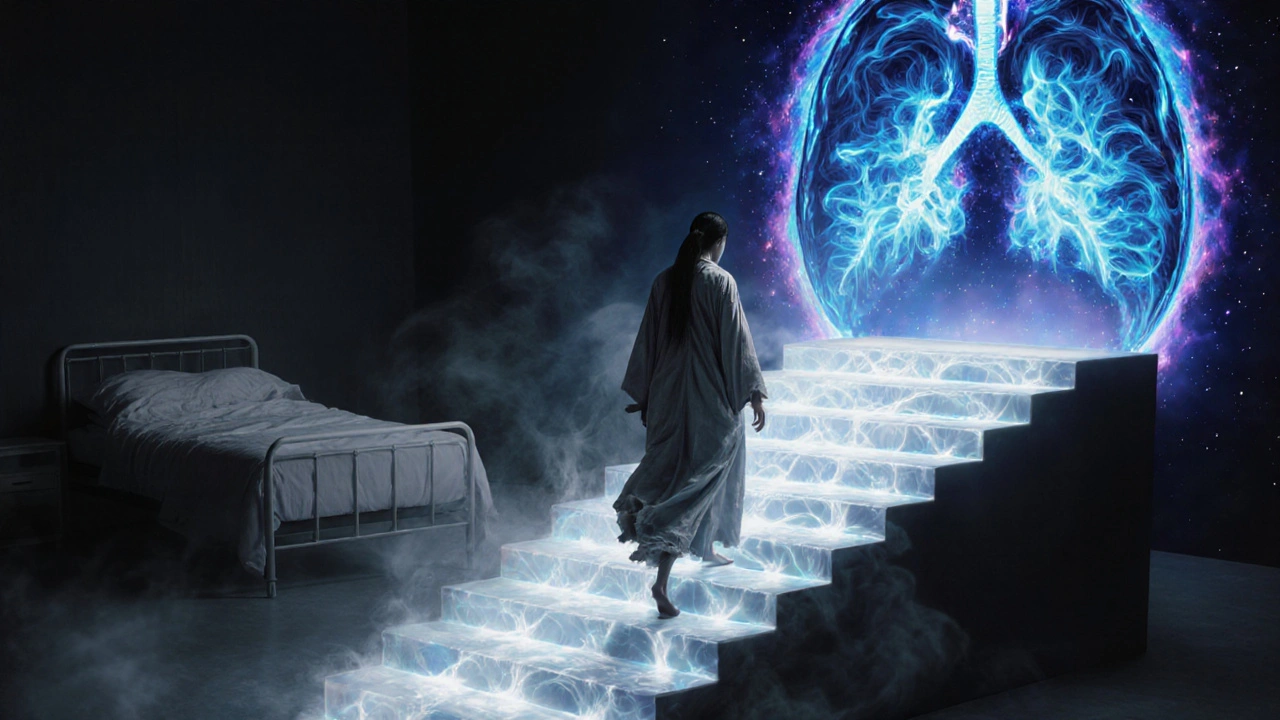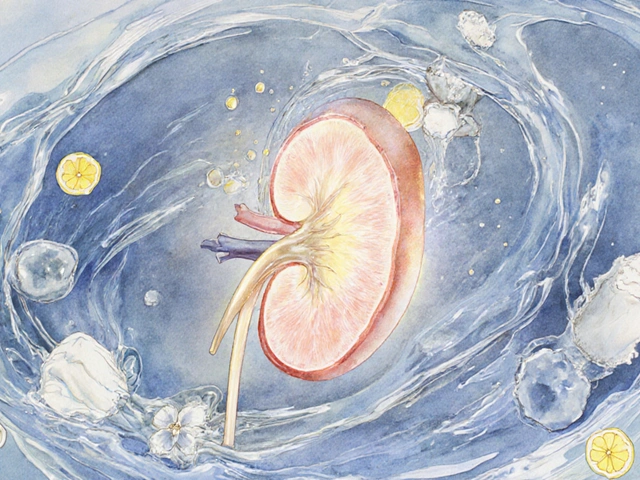
What Happens to Your Lungs After COVID-19?
Most people recover from COVID-19 without lasting issues. But for many, breathing problems don’t go away. Even after the virus is gone, lungs can keep hurting. This isn’t just feeling tired-it’s a real, measurable change in how oxygen moves through the smallest airways. Research from the Centre for Heart Lung Innovation shows that about one-third of long COVID cases involve lung damage that standard tests often miss.
What’s happening inside? Neutrophils, immune cells meant to fight infection, keep firing off inflammatory signals long after the virus is cleared. Think of them like dirty bombs that keep exploding in the lungs’ tiniest passages. This persistent inflammation scars the air sacs and thickens the walls of small airways, making it harder for oxygen to reach your blood. That’s why people feel out of breath walking up stairs or even talking on the phone.
Who’s Most at Risk for Lasting Lung Damage?
Not everyone gets the same long-term effects. People who were hospitalized with severe COVID-19 face the biggest risks. A South Korean study of over 5,700 patients found that 12.6% developed post-COVID pulmonary fibrosis (PCPF)-permanent scarring in the lungs. That number jumps even higher if you had pre-existing lung disease. People with COPD who got COVID-19 had a 4.6% death rate compared to 0% in those who didn’t get infected, and their flare-ups happened nearly twice as often.
Even those who weren’t hospitalized aren’t safe. A 2025 review of 50 studies showed that non-hospitalized patients still had 2.6 times higher risk of persistent breathlessness than people who never had COVID. The key difference? Hospitalized patients tend to have more severe, lasting damage. Those who needed a ventilator didn’t necessarily end up with worse lung function than those who didn’t-meaning even moderate cases can lead to long-term issues.
Why Standard Tests Often Miss the Problem
Here’s the frustrating part: your chest X-ray or even a CT scan might look normal. So might your spirometry test-the usual lung function check that measures how much air you can blow out. But you still feel like you can’t catch your breath. Why?
The damage isn’t in the big airways. It’s in the alveoli and tiny bronchioles where oxygen actually enters your blood. Traditional scans can’t see that. That’s where hyperpolarized xenon MRI comes in. This advanced imaging lets doctors watch oxygen move through the lungs in real time. Studies from the University of British Columbia’s HLI found four distinct patterns of gas exchange failure that only this technology can detect. It’s like having a flashlight for the invisible parts of your lungs.
Without this tool, many patients are told, “Your lungs are fine,” while they’re still struggling. That’s why symptoms like shortness of breath, fatigue after light activity, and brain fog often go untreated-because doctors can’t see the cause.

How Rehabilitation Can Help-And What It Includes
The good news? Your lungs can heal. Not always completely, but enough to get your life back. Pulmonary rehabilitation isn’t just walking on a treadmill. It’s a structured, 8- to 12-week program, usually 2-3 times a week, designed around your specific limits.
- Breathing exercises: Techniques like diaphragmatic breathing and pursed-lip breathing help reduce air trapping and improve oxygen flow.
- Aerobic training: Low-impact cycling, walking, or swimming builds endurance without overloading your lungs.
- Strength training: Light resistance work for arms and legs reduces the extra effort your body needs just to move.
- Education: Learning how to pace yourself, recognize early signs of overexertion, and manage anxiety around breathing.
A study from Italy showed that patients who completed rehabilitation improved their 6-minute walk distance by an average of 45 meters and saw measurable gains in lung diffusion capacity. Their dyspnea scores-their self-reported breathlessness-dropped significantly. The key? Starting early. Experts recommend beginning rehab at least four weeks after the acute phase, even if you still feel weak.
The Role of the mMRC Scale in Tracking Progress
Doctors use a simple tool called the mMRC dyspnea scale to measure how bad your breathlessness is. It asks you to pick one of five statements, like:
- 0: I only get breathless with strenuous exercise
- 1: I get breathless when walking up a hill
- 2: I walk slower than others because of breathlessness
- 3: I stop for breath after walking 100 yards
- 4: I’m too breathless to leave the house
If your score is 2 or higher one month after infection, you’re at high risk for long-term problems. That’s your signal to start rehab. But it’s not just a diagnosis tool-it’s a tracker. As you progress, your mMRC score should drop. If it doesn’t, your program needs adjusting.
What About Medications? Do They Help?
There’s no magic pill for long COVID lungs-but some drugs show early promise. The Korean study found that patients who received remdesivir during their acute infection were less likely to develop pulmonary fibrosis. On the flip side, those given baricitinib (an anti-inflammatory used in some severe cases) had a higher risk of scarring. Researchers warn this might be because baricitinib was given to sicker patients, not because it directly causes damage.
Right now, the focus is shifting to stopping the inflammation that keeps going after the virus leaves. Clinical trials are starting to test drugs that target neutrophils specifically. These aren’t available yet, but they’re the next big hope. For now, avoid unproven supplements or steroids unless prescribed. They can do more harm than good.

What’s New in 2025? Research and Guidelines Are Changing Fast
The field is moving quickly. The RECOVER Initiative, funded by the NIH, has mapped how lung damage links to other long COVID symptoms like kidney problems and extreme fatigue. Their September 2025 update showed that people with severe breathlessness also performed fewer sit-to-stand tests-just 8-10 reps in 30 seconds versus 15-20 for healthy peers. That’s now a standard clinical measure.
Major medical societies-the American Thoracic Society and the European Respiratory Society-are finalizing the first official diagnostic criteria for pulmonary long COVID, expected by the end of 2025. That means doctors will finally have a clear checklist: persistent symptoms after 12 weeks, abnormal xenon MRI findings, and exclusion of other causes.
Hospitals like Duke and the University of Kansas are now partnering with the HLI to offer xenon MRI scans to long COVID patients. It’s still not widely available, but it’s becoming more common in major medical centers.
What to Do If You’re Still Struggling to Breathe
If you had COVID-19 and still feel winded after 3 months:
- Don’t assume it’s just fatigue. Push for a referral to pulmonary rehab.
- Ask your doctor about an mMRC score. If it’s 2 or higher, rehab is urgent.
- Request a referral to a center that offers hyperpolarized xenon MRI if available.
- Track your daily activity. Use a simple log: how far you walked, how many stairs you climbed, how often you stopped to catch your breath.
- Avoid pushing through breathlessness. Overexertion can make symptoms worse.
Recovery isn’t linear. Some days you’ll feel better. Others, you’ll crash. That’s normal. The goal isn’t to get back to 100% overnight-it’s to build steady, sustainable improvement.
Can You Fully Recover?
For most, yes-eventually. Studies show lung function improves over six months for people with moderate to severe acute infections. Forced vital capacity (FVC), a key measure of lung volume, rose from 2.03 liters in hospitalized patients to 2.56 liters in outpatients over time. That’s a big jump.
But 12.6% of hospitalized patients develop permanent fibrosis. That means lifelong management-pulmonary rehab, oxygen therapy, regular check-ups. It’s not a death sentence. Many people with fibrosis live full lives with the right care.
The message is clear: don’t ignore lingering symptoms. Your lungs are still healing. And with the right support, you can get your breath-and your life-back.





Adam Dille
November 15, 2025 AT 03:11Katie Baker
November 16, 2025 AT 19:05John Foster
November 18, 2025 AT 16:06Edward Ward
November 19, 2025 AT 13:48Andrew Eppich
November 20, 2025 AT 16:19Jessica Chambers
November 22, 2025 AT 02:10Shyamal Spadoni
November 23, 2025 AT 08:42Ogonna Igbo
November 23, 2025 AT 13:32BABA SABKA
November 24, 2025 AT 17:00